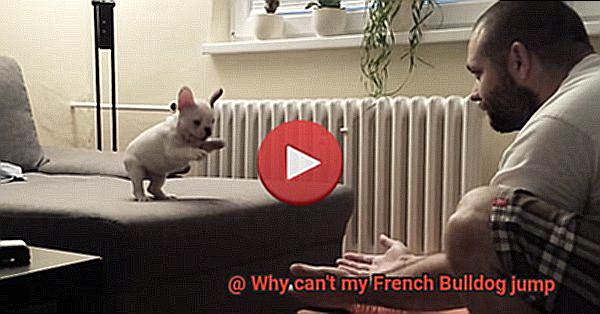Why can’t my French Bulldog jump?
Ever wondered why your French Bulldog can’t quite master the art of jumping? Don’t worry, you’re not alone. With their squishy faces and sturdy frames, French Bulldogs have an undeniable charm, but their jumping skills may leave you scratching your head. In this captivating blog post, we’ll dig deep into the fascinating reasons behind why French Bulldogs, despite their boundless energy, often struggle to soar through the air. From their unique physique to genetic quirks, we’ll explore the anatomy and genetics that contribute to our furry friends’ limited leaping abilities. Get ready to satisfy your curiosity and expand your knowledge as we unravel the enigma surrounding our beloved French Bulldogs’ jumping hurdles.
The Anatomy of a French Bulldog: Short Legs and Stocky Build
Contents [show]
French Bulldogs are undeniably adorable with their unique physical characteristics, but have you ever wondered why they can’t jump like other dog breeds? Well, it all comes down to their anatomy. Let’s dive into the fascinating world of a French Bulldog’s body structure and explore why their short legs and stocky build make jumping a challenge.
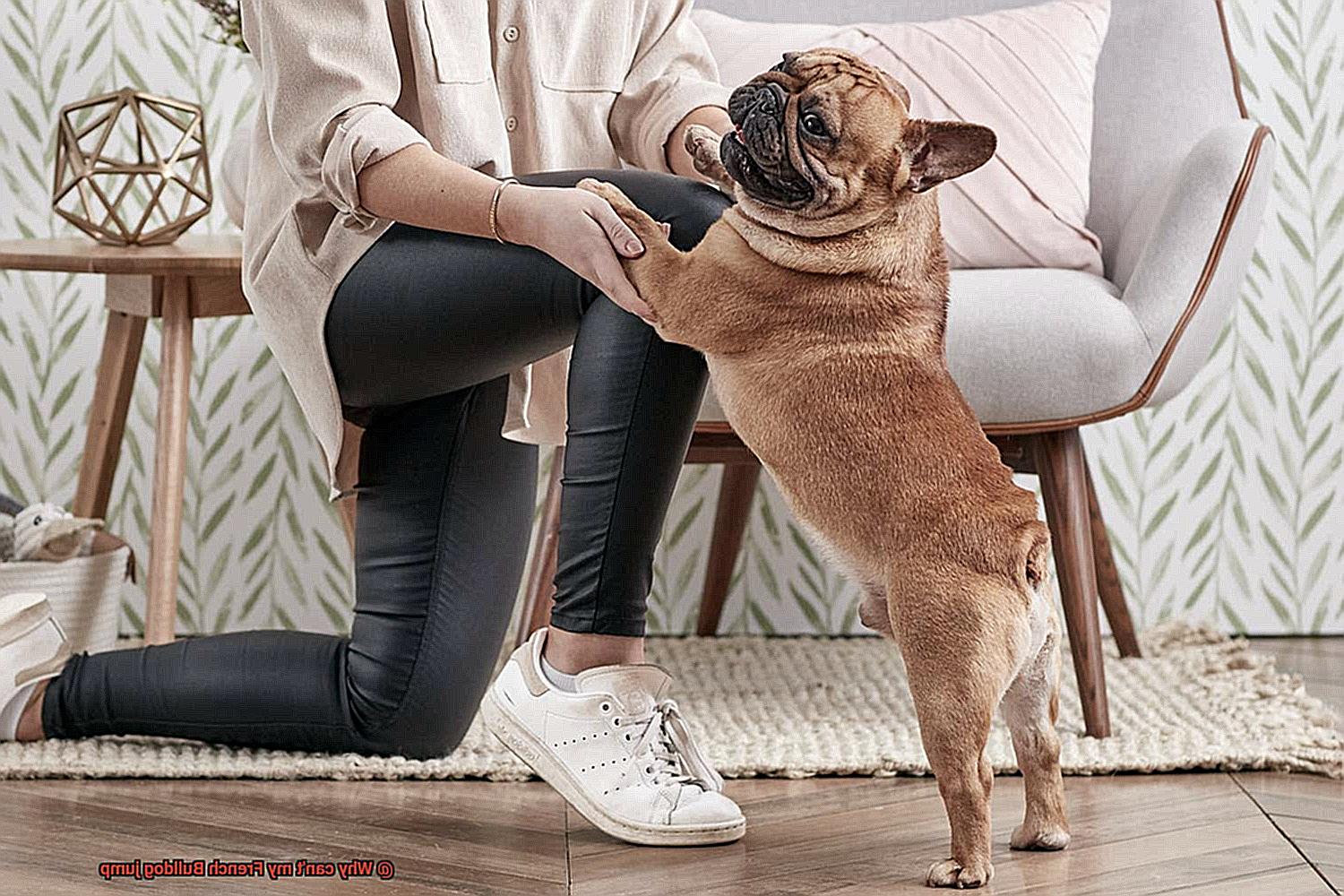
Short Legs: Genetic Quirk or Achondroplasia
French Bulldogs have short legs, and this is not just a random trait. It’s actually a result of their genetics. These little cuties have a condition called achondroplasia, which is a type of dwarfism. This condition affects the development of the long bones in their limbs, resulting in shorter legs compared to other dog breeds. So, when you see a French Bulldog strutting around with those adorable stubby legs, it’s all thanks to their unique genetic makeup.
Stocky Build: Stability and Balance
Another characteristic that contributes to their jumping limitations is their stocky build. French Bulldogs have a compact and muscular body, with a deep chest and broad shoulders. This body structure gives them stability and balance, making them excellent at activities that require strength, such as pulling or pushing. However, when it comes to jumping, their stocky build becomes a hindrance. The combination of short legs and a solid physique means that French Bulldogs do not have the same range of motion in their hindlimbs as other dog breeds.
Limited Range of Motion
French Bulldogs simply cannot extend their hind legs as far as other breeds can. Their hind limbs have limited extension, preventing them from propelling themselves high enough off the ground to execute a proper jump. It’s like trying to jump without fully extending your legs – it just doesn’t work. This limited range of motion is an inherent anatomical limitation that French Bulldogs have to contend with.
Weight and Joint Pressure
Another factor that adds to the difficulty of jumping for French Bulldogs is their relatively heavy body compared to their leg length. Their body weight puts more pressure on their joints and muscles, making it challenging for them to generate enough force to lift themselves off the ground. It’s like asking a weightlifter to jump as high as a gymnast – the physics just don’t add up.
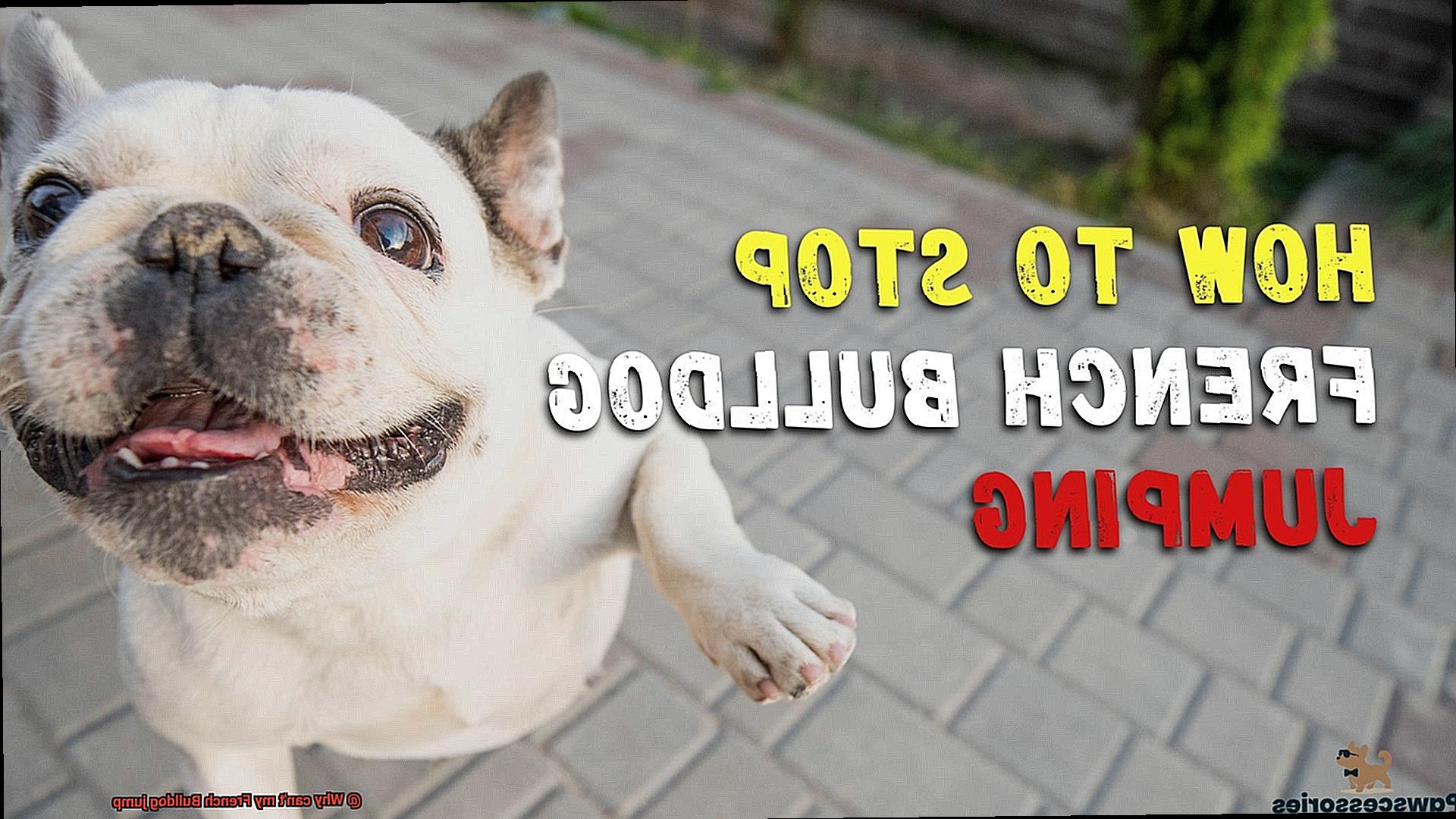
Respecting Your French Bulldog’s Limitations
As responsible owners, it’s crucial for us to understand and accept our French Bulldogs’ limitations when it comes to jumping. Trying to force them to jump or expecting them to perform like other dog breeds can lead to injuries or discomfort for our furry friends. Instead, we should focus on engaging them in activities that suit their abilities and keep them physically active without putting unnecessary strain on their bodies.
The Impact of Their Head Size on Balance and Stability
French Bulldogs are known for their unique head shape, characterized by a large and square skull, paired with a short and flat face. While these features contribute to their adorable appearance, they also have an impact on their balance and stability, particularly when it comes to jumping.
Center of Gravity
One of the main factors affected by their head size is their center of gravity. The weight of their head is positioned higher up compared to other dog breeds, making it harder for them to maintain balance while jumping. This can cause difficulties in achieving the necessary coordination and control required for successful jumps.
Brachycephaly and Breathing Difficulties
The short and flat face of French Bulldogs, known as brachycephaly, is associated with a shorter snout and compressed airways. This can lead to breathing difficulties, especially during physical exertion. As a result, French Bulldogs may struggle with the increased respiratory demand of jumping, further limiting their ability to perform this activity.
Vision Challenges
The brachycephalic features of French Bulldogs can also affect their vision. Their eyes are positioned more towards the sides of their head, giving them a wider field of vision but reducing their depth perception. This limited depth perception makes it challenging for them to accurately judge distances and heights, making jumping a risky task for them.
Weight Distribution
Additionally, the weight distribution of a French Bulldog’s head can make it harder for them to generate enough force to propel themselves upwards. Their large and heavy head requires more effort to lift, which can be physically demanding and tiring for them.
Individual Variations
It is important to note that not all French Bulldogs will have the same level of difficulty in jumping. Factors such as overall health, muscle tone, and body weight can vary among individuals, leading to differences in agility and athleticism. However, the general characteristics of their head size and structure still play a significant role in their jumping abilities.
Alternative Forms of Exercise
Given the limitations in jumping, it is recommended that owners of French Bulldogs provide alternative forms of exercise that are less strenuous on their joints and respiratory system. Activities such as walking, swimming, or playing gentle games can be more suitable for their physical capabilities.
Seeking Veterinary Guidance
If a French Bulldog is struggling with jumping or shows signs of discomfort during physical activity, it is advisable to consult with a veterinarian. They can evaluate the specific case and provide guidance on appropriate exercise routines, as well as address any underlying health issues that may be contributing to the difficulty in jumping.
Brachycephalic Structure: Breathing Difficulties That Affect Jumping
French Bulldogs are beloved companions known for their charming personalities and distinctive brachycephalic structure. While their adorable appearance captivates many, it is important for owners to understand the potential challenges that come with this unique head shape.
In this article, we will delve into how the brachycephalic structure can affect a French Bulldog’s ability to jump and provide insights on managing their exercise routine.
The Role of Brachycephalic Structure in Breathing Difficulties:
Brachycephalic structure refers to the short, broad skull shape that is characteristic of certain dog breeds, including French Bulldogs. This structure can lead to breathing difficulties due to narrowed nostrils, an elongated soft palate, and a small windpipe. These anatomical features can obstruct airflow, making it harder for French Bulldogs to breathe, especially when engaging in physically demanding activities like jumping.
Impacts on Oxygen Intake and Energy Levels:
When a French Bulldog exerts themselves physically, their compromised respiratory system may struggle to deliver enough oxygen to meet their body’s needs. As a result, they may experience panting, wheezing, and reduced energy levels during and after jumping. It is crucial for owners to be mindful of these breathing difficulties and provide appropriate exercise and rest periods to prevent overexertion.
Heat and Humidity: Additional Challenges for Brachycephalic Dogs:
The brachycephalic structure poses even greater challenges for French Bulldogs in hot or humid weather conditions. Their compromised respiratory system makes it harder for them to cool down efficiently, putting them at a higher risk of heatstroke. Owners must take extra precautions during these conditions and prioritize their pet’s safety by limiting strenuous activities like jumping.
Joint Health Considerations:
Jumping requires significant exertion and impacts on joints. Due to their body structure, French Bulldogs with brachycephalic structure may be more prone to joint issues. Owners should exercise caution when allowing their pets to jump from heights, as the impact on their joints can be more significant. Consulting with a veterinarian about suitable exercise options and managing joint health is crucial for maintaining their overall well-being.
Surgical Intervention:
In severe cases of breathing difficulties, surgical intervention may be necessary to improve a French Bulldog’s quality of life and enable them to engage in physical activities like jumping. Procedures such as widening the nostrils or shortening the soft palate can help alleviate respiratory obstructions and enhance their ability to breathe and exercise comfortably.
Spinal Issues: Intervertebral Disc Disease and Limited Flexibility
Today, we’re going to dive into a topic that affects our beloved furry friends – spinal issues and how they can lead to limited flexibility and jumping ability in French Bulldogs. So, let’s get started.
Understanding Intervertebral Disc Disease (IVDD):
One of the common spinal issues that can plague French Bulldogs is intervertebral disc disease, also known as IVDD. IVDD affects the spinal discs, which act as shock absorbers and allow for flexibility and movement between the bones of the spine. Unfortunately, our little Frenchies are genetically predisposed to certain spinal abnormalities, making them more susceptible to IVDD.
The Impact of IVDD on French Bulldogs:
The unique physical characteristics of French Bulldogs, such as their short and compact bodies, combined with their large heads and heavy front ends, place additional strain on their spines. Over time, this can lead to the degeneration of the intervertebral discs, making them less flexible and more prone to injury.
Limited Flexibility and Jumping Ability:
When a French Bulldog develops IVDD, the affected discs can bulge or herniate, putting pressure on the spinal cord or nerves. This can result in pain, weakness, and loss of coordination in the affected area. In severe cases, it can even lead to paralysis. Given these challenges, it’s no surprise that our Frenchies may have limited jumping ability.
Preventing and Managing Spinal Issues:
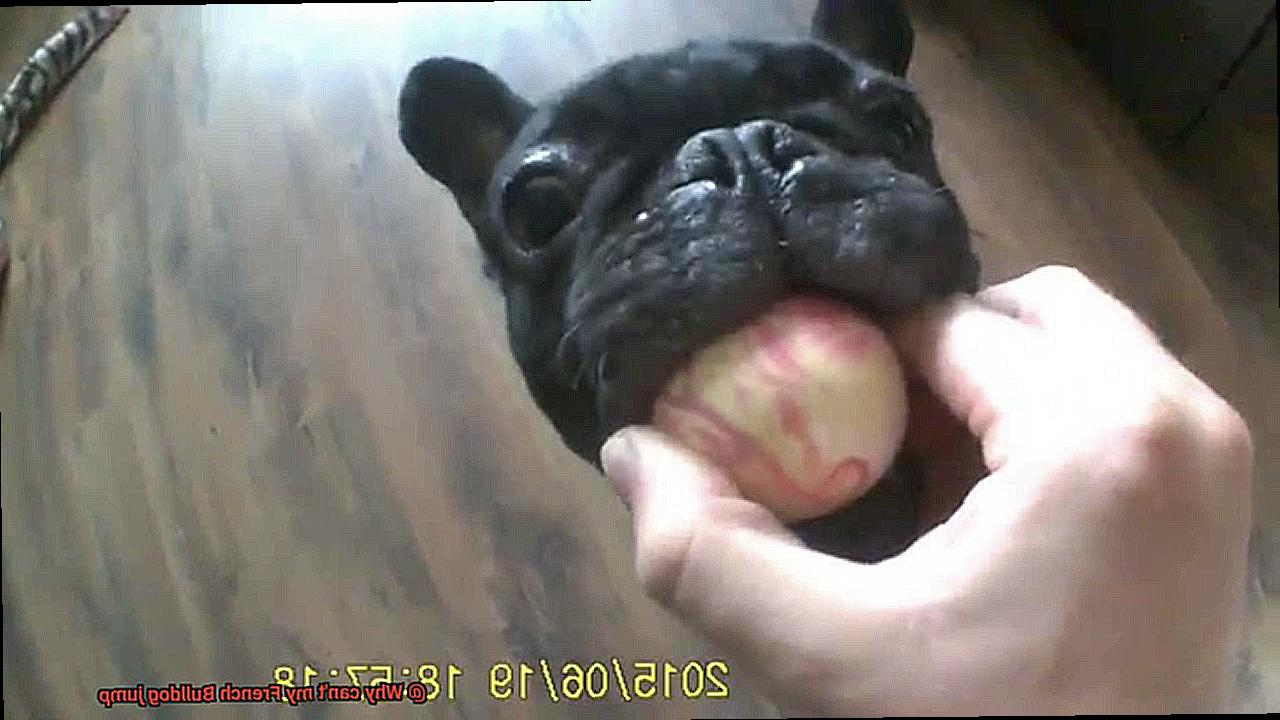
Prevention is key when it comes to maintaining the overall spinal health of our French Bulldogs. Regular exercise is essential for keeping their muscles strong and reducing the risk of obesity. However, it’s important to avoid activities that put excessive strain on their spines, such as jumping from heights or participating in high-impact sports.
If you suspect that your French Bulldog is experiencing spinal issues or has limited flexibility, it’s crucial to seek veterinary advice. A veterinarian specializing in orthopedics or neurology can conduct a thorough examination, including imaging tests like X-rays or MRI scans, to accurately diagnose any underlying conditions.
Treatment options for IVDD may include rest, anti-inflammatory medications, physical therapy to strengthen surrounding muscles, and in severe cases, surgery to alleviate pressure on the spinal cord and repair damaged discs.
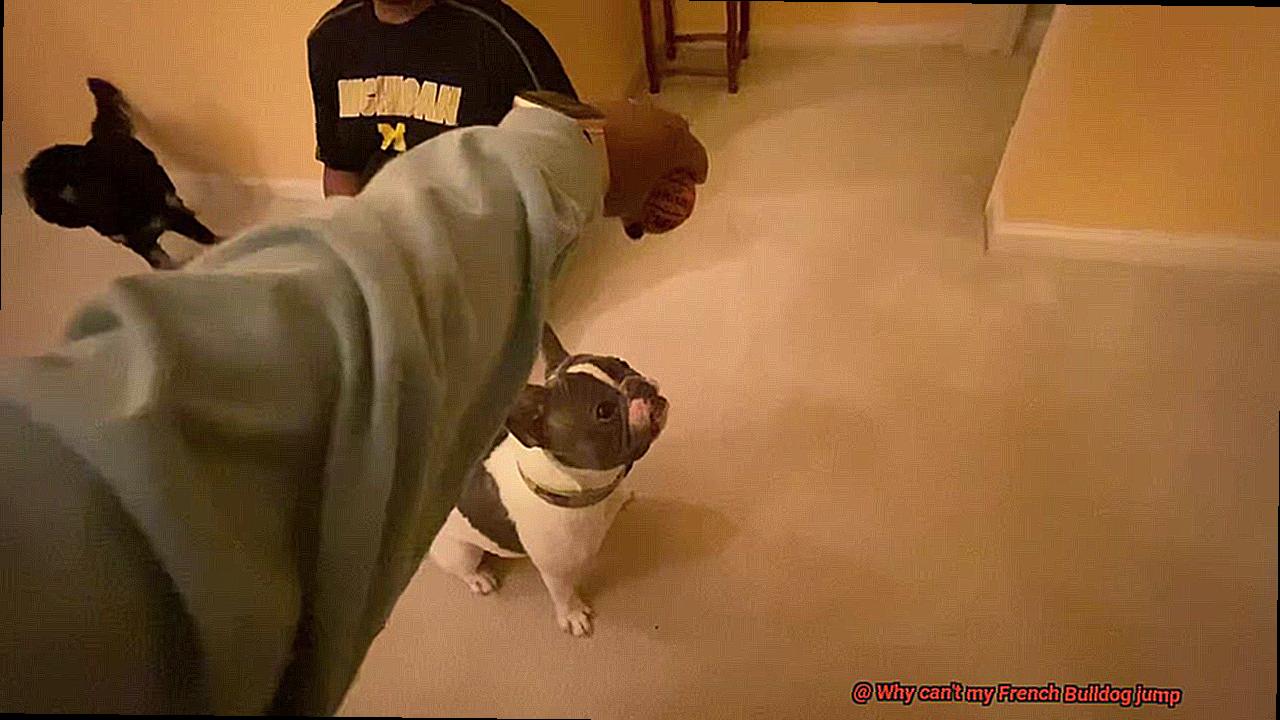
Health Conditions That Can Affect Jumping Ability
In this blog post, we will explore common health conditions that can hinder your French Bulldog’s jumping prowess and provide insights based on real experiences and credible sources. So, let’s dive in and learn how to keep your Frenchie bouncing with joy.
Hip Dysplasia:
Hip dysplasia is a genetic condition where the hip joint does not develop properly, leading to instability and discomfort. Jumping can be challenging or painful for dogs with hip dysplasia. To help manage this condition, consult your veterinarian for appropriate treatment options, such as weight management, exercise modification, and pain management techniques.
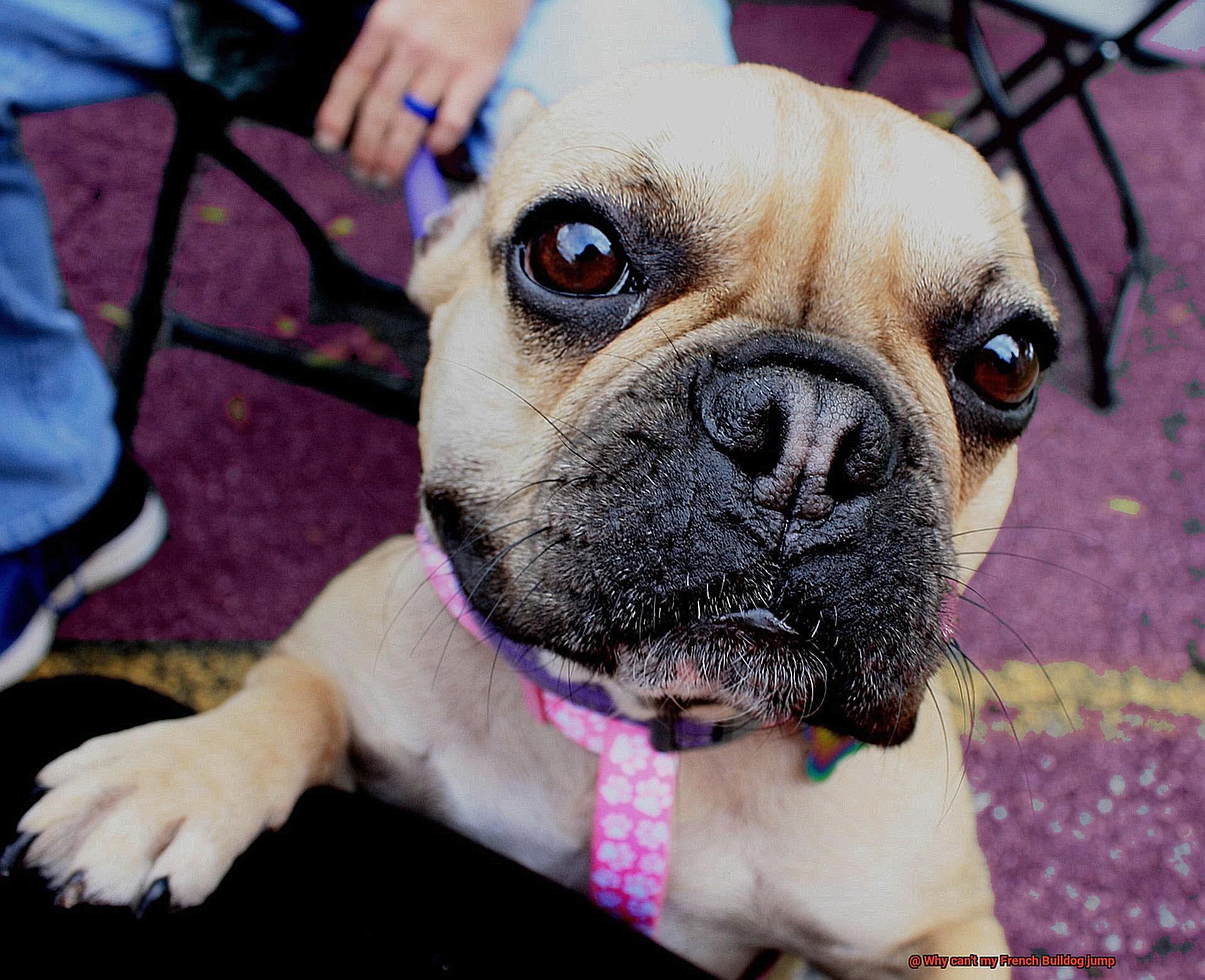
Patellar Luxation:
Patellar luxation occurs when the kneecap slips out of its normal position, causing pain and difficulty in movement. Affected French Bulldogs may struggle to jump or hesitate due to discomfort. Regular check-ups with a veterinarian will help monitor this condition and determine if any interventions, such as surgery or physical therapy, are necessary.
Spinal Issues:
Intervertebral disc disease (IVDD) is a common spinal issue in French Bulldogs. It involves the degeneration or herniation of discs in the spine, resulting in pain, weakness, and loss of coordination. Dogs with IVDD may find it challenging to jump or avoid it altogether to prevent further injury. Early intervention and proper management through veterinary guidance can improve their jumping abilities.
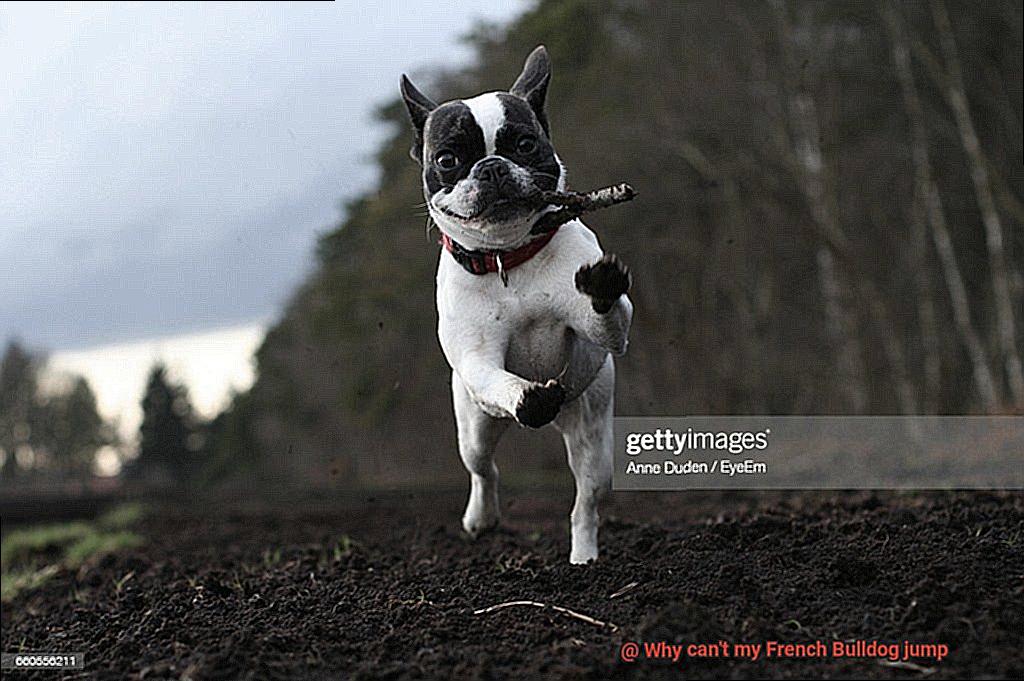
Obesity:
Excess weight puts strain on a French Bulldog’s joints and muscles, making jumping difficult. Maintain your Frenchie’s healthy weight through a balanced diet and regular exercise tailored to their needs. Consult your veterinarian for personalized recommendations.
Respiratory Conditions:
Brachycephalic airway syndrome, common in French Bulldogs due to their short snouts and narrow airways, can affect their ability to jump. These dogs may experience breathing difficulties during exercise and avoid physically demanding activities like jumping. Ensure a cool and well-ventilated environment during exercise and consult your veterinarian for management strategies.
Age-Related Joint Problems That Limit Mobility
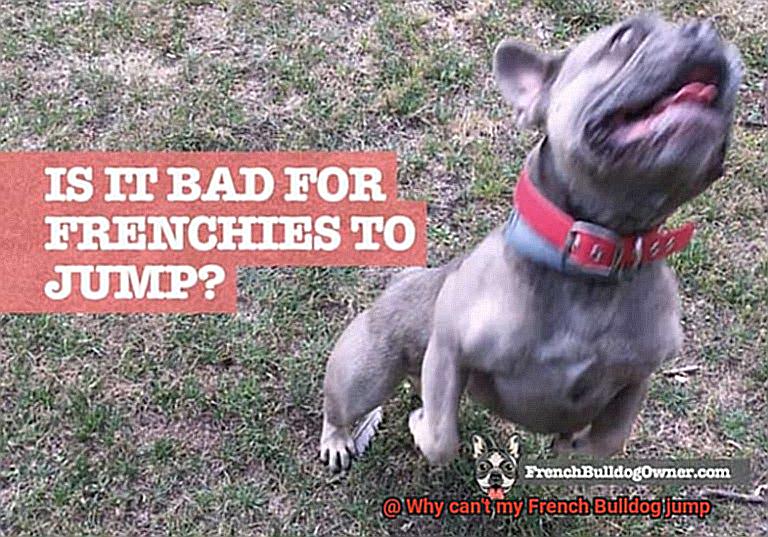
As our beloved French Bulldogs age, they may encounter joint problems that can limit their mobility and hinder their ability to jump, run, and play. In this article, we will explore the common age-related joint problems that affect French Bulldogs and provide tips on how to manage and improve their mobility.
Hip Dysplasia:
Hip dysplasia is one of the most prevalent joint problems in French Bulldogs. It occurs when the hip joint doesn’t develop properly, leading to instability and eventual arthritis. Signs of hip dysplasia include difficulty standing up, a bunny-hop gait, and reluctance to exercise. To manage hip dysplasia, your veterinarian may recommend weight management, physical therapy exercises, pain medication, or even surgical interventions like hip replacement.
Patellar Luxation:
Patellar luxation is another joint problem commonly seen in French Bulldogs. It occurs when the kneecap dislocates from its normal position. This condition can cause pain and difficulty in jumping or running. Treatment options for patellar luxation include weight management, physical therapy exercises, anti-inflammatory medications, or surgery if necessary.
Intervertebral Disc Disease (IVDD):
French Bulldogs are prone to developing intervertebral disc disease (IVDD), which affects the spinal discs and can result in pain, nerve damage, and loss of mobility. Signs of IVDD include reluctance to move, difficulty walking, or dragging of the hind legs. Treatment options for IVDD may include medication for pain management, strict rest periods, physical therapy exercises, or in severe cases, surgery.
Degenerative Joint Disease (DJD):
As French Bulldogs age, they may also suffer from degenerative joint disease (DJD), also known as osteoarthritis. DJD causes the cartilage in the joints to deteriorate, leading to stiffness, pain, and limited range of motion. Management of DJD in French Bulldogs may involve weight management, joint supplements, medications for pain relief, physical therapy exercises, or alternative therapies like acupuncture.
Obesity and Joint Problems:
Obesity can exacerbate joint problems in French Bulldogs as it puts additional strain on their already compromised joints. It is crucial to maintain a healthy weight for your Frenchie through proper diet and regular exercise. Consult with your veterinarian to determine the appropriate feeding regimen and exercise routine for your dog.
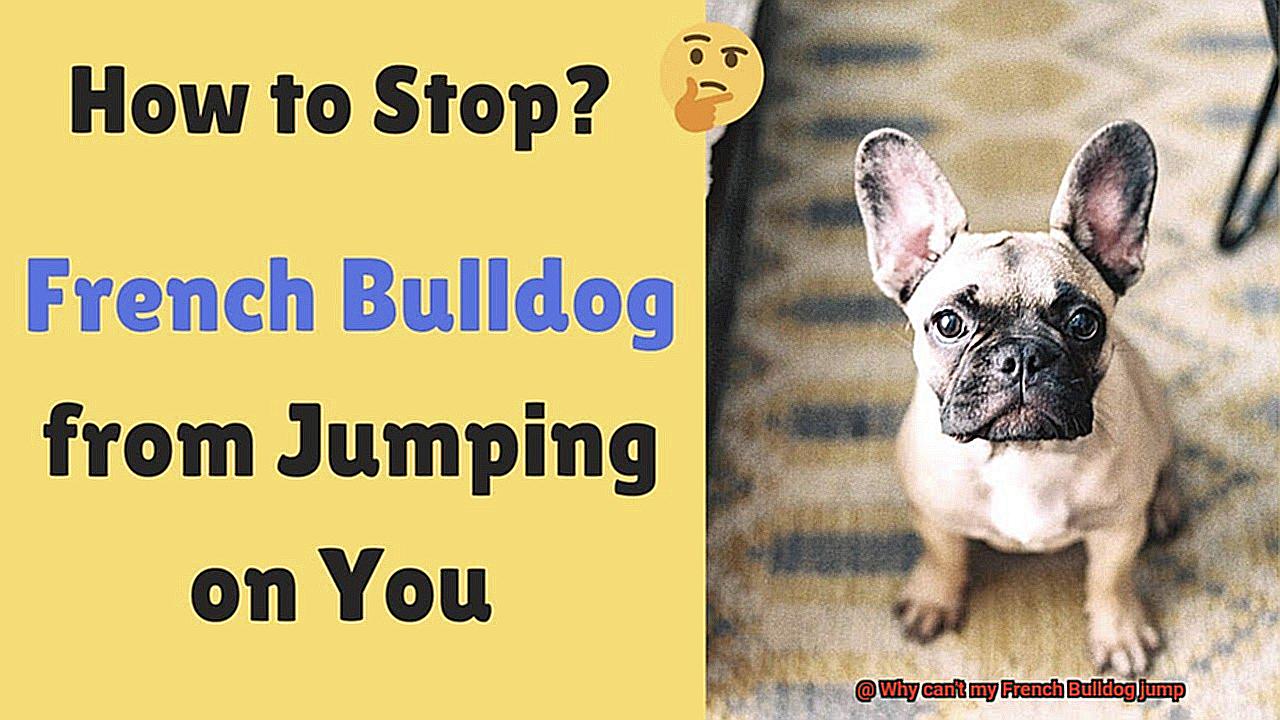
Tips for Owners of French Bulldogs to Consider When it Comes to Jumping
French Bulldogs are adorable and lovable companions, but when it comes to jumping, they may not be as agile as other breeds. The reasons behind their limited jumping abilities lie in their unique body structure and physical limitations.
Firstly, French Bulldogs have short and stout legs. These little powerhouses have hind legs that are shorter in proportion to their body size, making it challenging for them to generate the power needed to jump high or far. Their compact build simply doesn’t lend itself well to leaping.
Another factor is their brachycephalic facial structure. The flat face that makes French Bulldogs so cute can also impact their breathing and overall respiratory function. Due to narrow airways, these adorable pooches can find it harder to breathe efficiently during activities that require physical exertion, such as jumping.
Mindful play
Avoid encouraging or forcing your French Bulldog to jump excessively. While it may seem entertaining, excessive jumping can strain their joints and muscles, leading to potential injuries or long-term health issues.
Alternative access
Provide ramps or stairs to help your furry friend reach elevated surfaces like beds or couches instead of relying on jumping. This reduces stress on their joints and minimizes the risk of injury.
Weight management
Keep an eye on your French Bulldog’s weight. Extra pounds can strain their already compromised joints and make it even harder for them to jump. Maintain a healthy weight through balanced diet and regular exercise.
Low-impact exercises
Engage in low-impact activities like walking or swimming that promote strength and mobility without excessive strain on their joints. Consult with your veterinarian for a suitable exercise routine.
Joint health support
Consider providing your French Bulldog with joint supplements to support their joint health and reduce inflammation, promoting overall mobility and comfort.
Alternative Forms of Exercise for French Bulldogs
French Bulldogs may not be the best jumpers, but that doesn’t mean they can’t stay active and fit. In fact, there are plenty of alternative forms of exercise that are perfect for these adorable pups. So put on your walking shoes and let’s explore some fun and low-impact activities for your French Bulldog.
- Walking: The classic form of exercise, walking is a fantastic way to keep your Frenchie moving. Take them out for a daily stroll around the neighborhood or find a nearby park where they can explore new scents and sights. Just make sure to keep the walks moderate in duration to avoid overexertion.
- Swimming: Did you know that French Bulldogs are natural swimmers? Their sturdy build and muscular bodies make them great in the water. Find a dog-friendly beach or pool and let them splash around. Not only is swimming easy on their joints, but it also provides an excellent cardiovascular workout.
- Interactive Toys: Keep your Frenchie entertained and active with interactive toys. Look for puzzle toys or treat-dispensing toys that require them to move and think. Not only will this provide physical exercise, but it will also stimulate their minds.
- Agility Training: While French Bulldogs may not excel at high jumps, they can still participate in agility training at a modified level. Set up low obstacles and hurdles that don’t strain their joints too much. It’s a great way to keep them active and engaged while working on their coordination skills.
- Mental Stimulation: Exercise doesn’t always have to be physical. Mental stimulation is just as important for French Bulldogs. Engage them in activities like obedience training, scent work, or trick training. Not only will this challenge their minds, but it will also strengthen the bond between you and your furry friend.
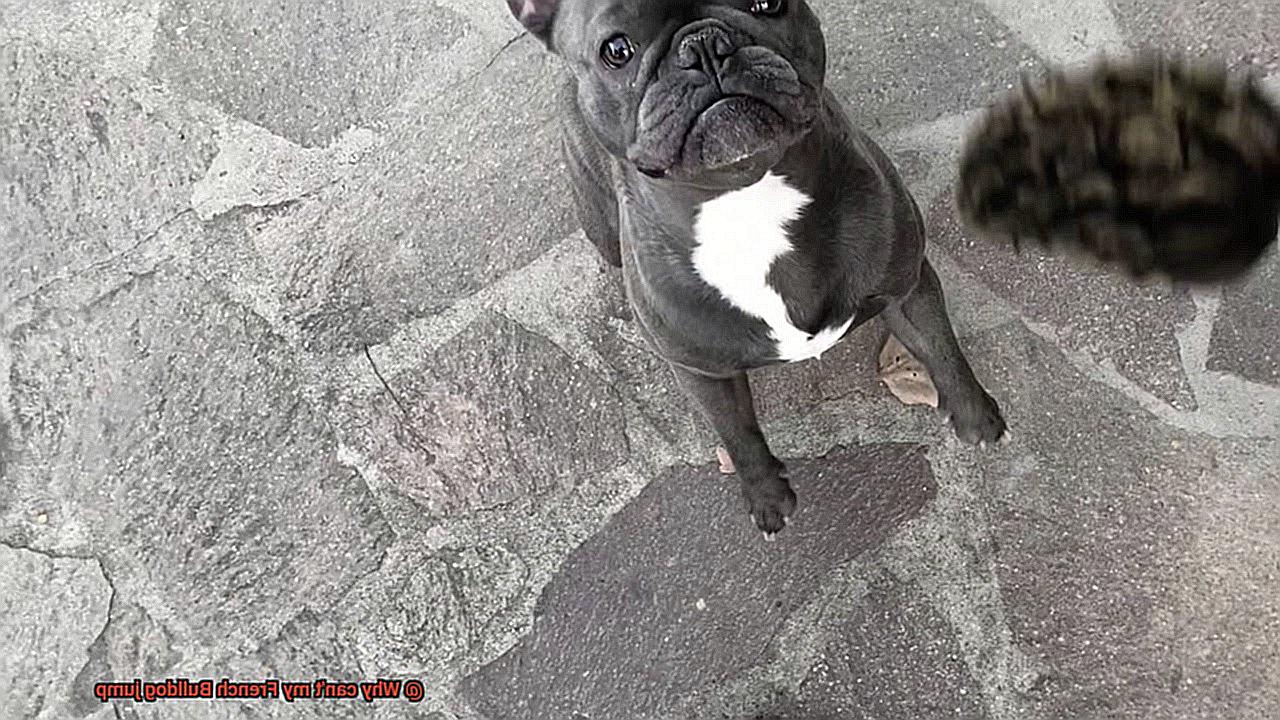
Remember, every French Bulldog is unique, so it’s essential to consult with a veterinarian or professional trainer for exercise recommendations tailored to your dog’s individual needs and abilities. And as always, keep an eye out for any signs of discomfort or exhaustion during exercise.
AF5fgs7hQXw” >
Conclusion
French Bulldogs, despite their adorable appearance and playful nature, often struggle with jumping.
This is due to their unique physical characteristics and genetic predispositions. Their compact and muscular bodies, combined with their short legs and a heavy head, make it challenging for them to generate enough power to propel themselves off the ground.
It’s important for owners of French Bulldogs to understand and accommodate these limitations by providing alternative forms of exercise and ensuring a safe environment for their furry friends.
